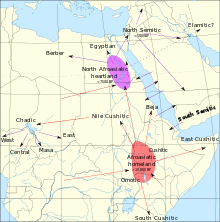Proto-Afroasiatic language

Proto–Afroasiatic is the hypothetical proto-language from which all modern Afroasiatic languages are descended. It is believed by scholars to have been spoken as a single language around 8,000 BCE.
Consonant correspondences
The following table shows consonant correspondences in Afroasiatic languages, along with some reconstructed consonants for Proto-Afroasiatic.
| Proto-Afroasiatic | Proto-Semitic | Egyptian | Berber | East Cushitic | West Chadic |
|---|---|---|---|---|---|
| *b | *b | b | *β, ? *b, *-∅- | *b | *b, *ḅ1 |
| *p | *p | p | *f, ? *b | *p | *p, *f, *ḅ1 |
| *f | f | f | |||
| *d | *d | d | *d | *d | *d, *ḍ1 |
| *t | *t | t | *t | *t | *t |
| *ṭ | *ṭ | d(~t) | *ḍ [dˁ] / *ṭ (→ *ṭṭ [tˁː]) | *ṭ (→ *ḍ) | *ḍ |
| *ð | ?? d | *z | *z | *dʒ | |
| *θ | s, ?? š | *s | *s1(=*s) | ||
| *θ̣ | ḏ- | *ẓ [zˁ] | South Cushitic *ṭṣ |
||
| *z | z | *z | *z | *dz | |
| *s | *s | s | *s- ? | *s1|s2- | *ts |
| *ṣ [(t)sʼ] | ḏ | *ẓ [zˤ] | *ṭṣ | *ṭṣ | |
| *š (*s2) | s | *s | *s2(=*š) | s, Central Chadic: *s, *ɬ | |
| *ś (*s3) [ɬ] | š, ? s | *s, *z- | *l, SCush. *ɬ |
*ɬ, *ɮ | |
| *ṣ́ (*ṣ3) [(t)ɬʼ] | ḏ, ? d- | *s1 ?, SCush. *ṭɬ̣ |
-*ṭɬ̣- | ||
| *g | g, ḏ | *g | *g | *g | |
| *k | k, ṯ | *k, ? *ɣ | *k | *k | |
| *ḳ | q, ḏ | *ɣ, ? *ḳ (→ *ḳḳ [kˤː]) | |||
| *ɣ | χ-, ʕ- ? | *h2 | *ʕ | ||
| *χ | χ, ẖ, ħ | *H- | *h-, *-Ø- | *-H-? | |
| *ʕ | ʕ | *H- | *ʕ-, *-Ø-ʔ | ||
| *ħ | ħ | *H- | *ħ-, *-Øː- | ||
| *h | ı͗- | *h1, *h2 | *ʔ- | ||
| *ʔ | ı͗, ? ꜣ | *ʔ | *ʔ, -Ø- | *ʔ | |
| *r | ꜣ, r | *r | -*r- | *r | |
| *l | n-, [l-], r, ꜣ | *l | -*l- | *l | |
| *w | w-, ı͗, y | *w, *Ø | *w, *Ø | *w-? | |
| *y | ı͗-, y-, -Ø- | *y, *i, *Ø | *y, *i, *Ø | *y, *Ø | |
| Proto-Afroasiatic | Proto-Semitic | Egyptian | Berber | East Cushitic | West Chadic |
- under special conditions
NOTE:
- š = /ʃ/
- Symbols with dots underneath are emphatic consonants (variously glottalized, ejective or pharyngealized).
- Transcription of Ancient Egyptian follows Allen (2000); see Transliteration of Ancient Egyptian. The following are possible values for the non-IPA symbols used for Ancient Egyptian: ẖ = [ç]; ṯ = [tʲ] or [t͡ʃ]; ḏ = [dʲ] or [d͡ʒ], or ejective [tʲʼ] or [t͡ʃʼ].
Pronouns
Ehret (1995) reconstructs the following pronouns, most of which are supported by at least five of the six branches:
| Singular, bound | Singular, independent | Plural | |
|---|---|---|---|
| 1 | *i, *yi | *(ʔ)ân-/(ʔ)în- | *(ʔ)ǎnn-/(ʔ)ǐnn- |
| 2 m. | *ku, *ka | *(ʔ)ânt/(ʔ)înt- | *kuuna |
| 2 f. | *ki | ||
| 3 | *si, *isi | *su, *usu | |
Numerals
Ehret (1995) reconstructs the following cardinal numbers (Ehret does not include Berber in his reconstruction):
| Number | Proto-Afroasiatic | Proto-Semitic | Egyptian | Proto-Cushitic | Proto-Chadic | Proto-Omotic |
|---|---|---|---|---|---|---|
| two | *tsan, *can | *θny | snwj | |||
| *tsîr(n), *cîr(n) | *θər | *sər | ||||
| *ɬâm- | *ɬmʔl "left hand" | *ɬâ(a)m- | *lam- | |||
| three | *xaynz- | *knɗ- | *x2ayz- | |||
| four | *fâzw- | fdw | *fʷaɗə |
The first root for "two" has been compared to Berber (Tamazight) sin.[4] There are other proposed cognate sets:
- "six": Egyptian srs, Proto-Semitic *šidṯ-, Berber (Tamazight) seddis[4]
- "seven": Egyptian sfḫ, Proto-Semitic *šabʕ-, Berber (Tamazight) sa.[4]
Homeland
The size of the Afroasiatic language area prior to its expansion in the historic era has guided speculation about the areas where that language family's original homeland or Urheimat could be. Generally speaking, two proposals have been developed: that Afro-Asiatic arose near the Semitic Urheimat in the Middle East, or that Afro-Asiatic languages arose in northeast Africa (generally, either between Darfur and Tibesti or in Ethiopia and the other countries of the Horn of Africa).
See also
Notes
- ↑ Dolgopolsky (1999), pp. 38-39.
- ↑ Prasse (2000), p. 346.
- ↑ 3.0 3.1 Ehret (1995)
- ↑ 4.0 4.1 4.2 Takács, Gábor (1999-). Etymological Dictionary of Egyptian. Brill. Check date values in:
|date=(help)
References
- Dolgopolsky, Aron (1999). From Proto-Semitic to Hebrew. Milan: Centro Studi Camito-Semitici di Milano.
- Ehret, Christopher (1995). Reconstructing Proto-Afroasiatic (Proto-Afrasian): vowels, tone, consonants, and vocabulary. University of California Press. ISBN 0-520-09799-8.
- Prasse, Karl G. (2000). Études berbères et chamito-sémitiques: mélanges offerts à Karl-G. Prasse.